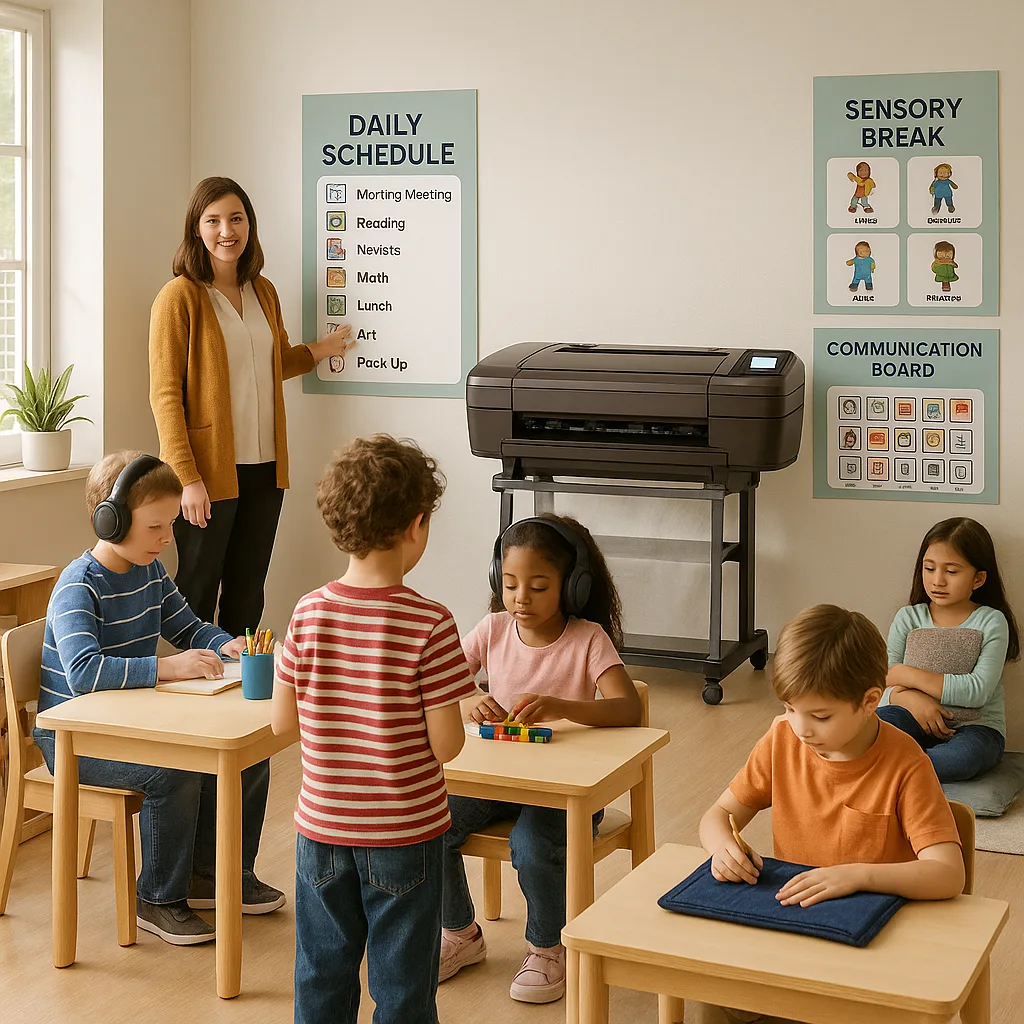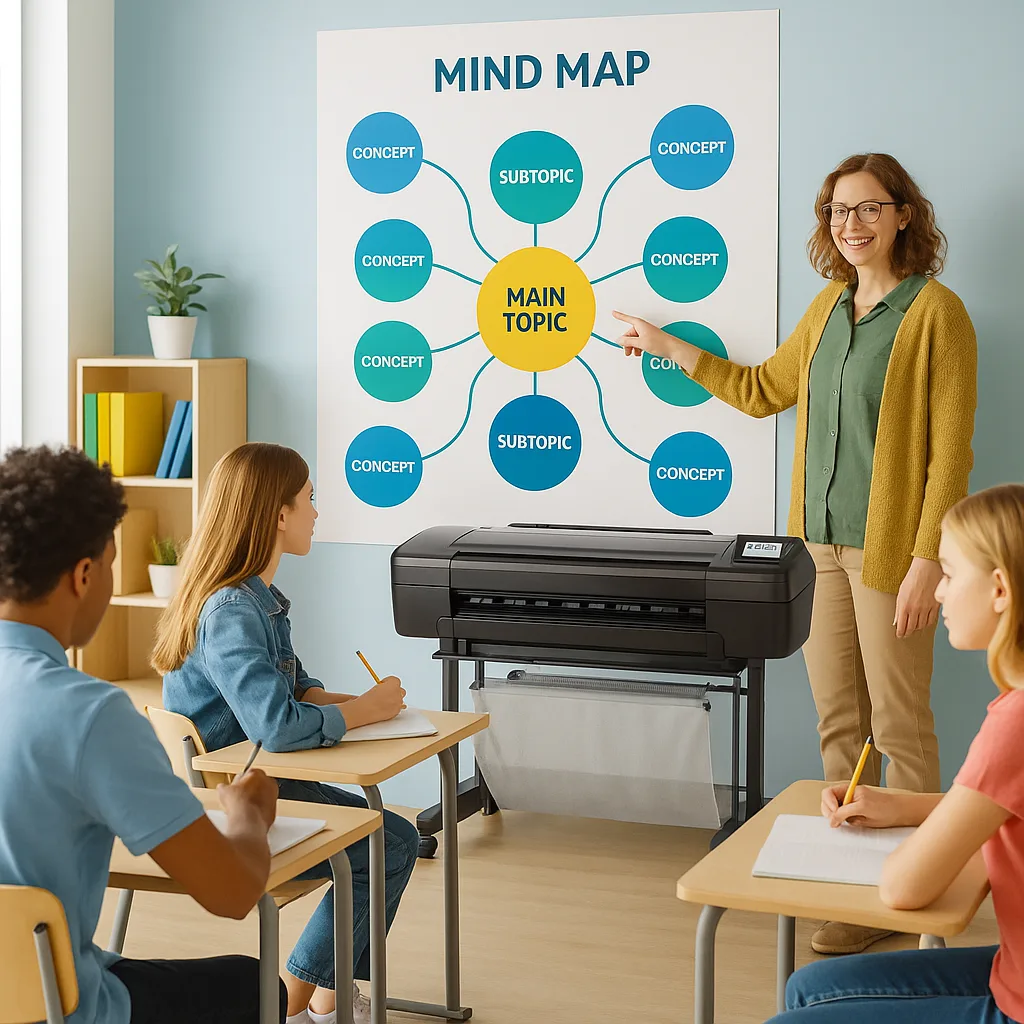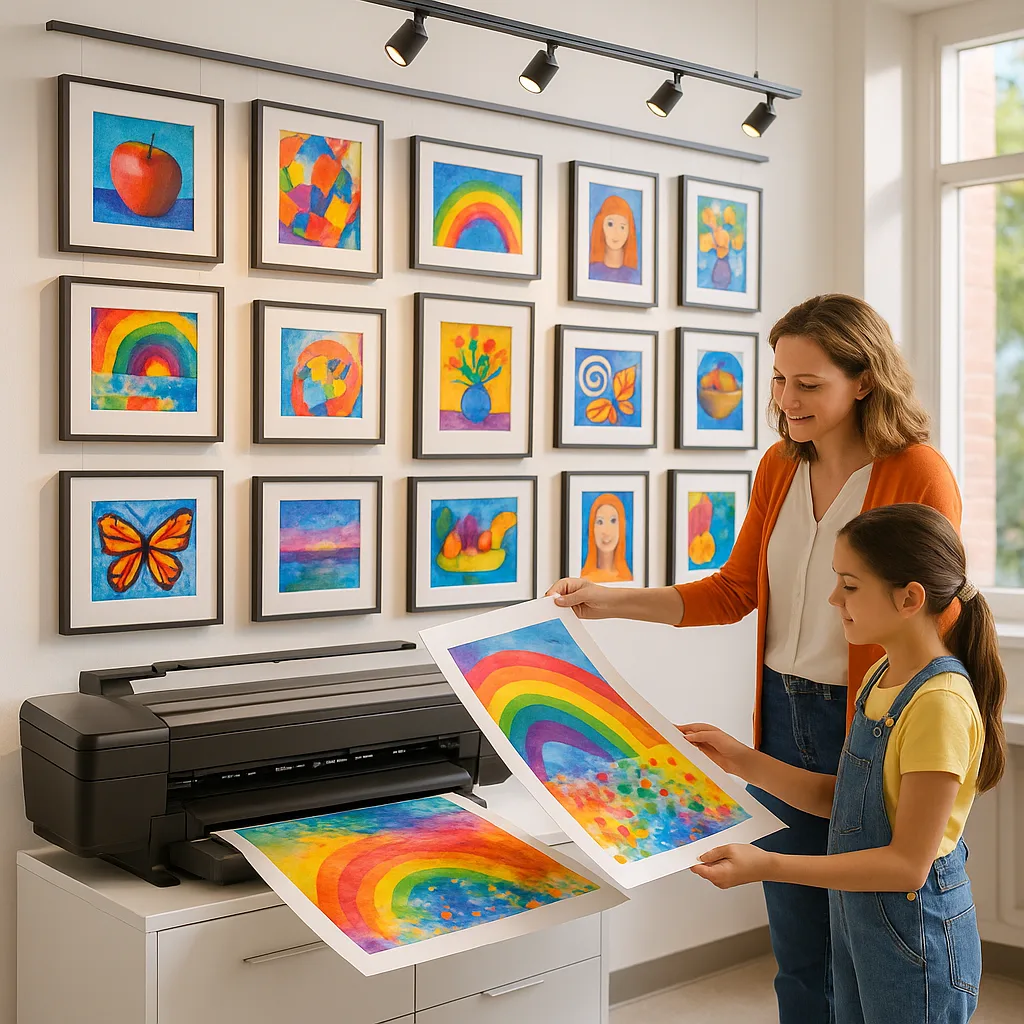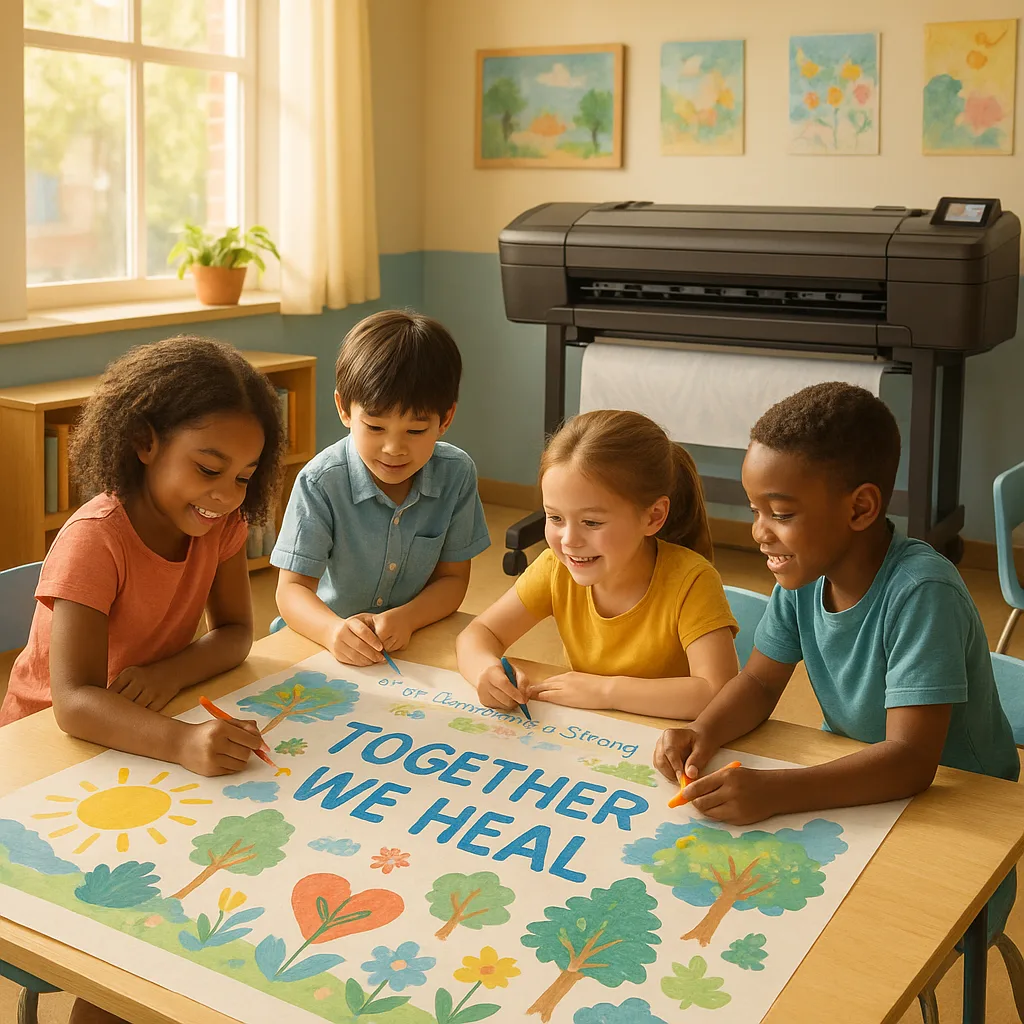
Last spring, I watched a third-grade teacher transform her classroom after a devastating tornado swept through their community. Instead of pretending nothing happened, she used their poster printer for schools trauma healing to create a visual journey that acknowledged pain while building hope. Within weeks, her students went from withdrawn silence to actively creating their own healing posters, turning collective trauma into collective strength.
Understanding Visual Processing During Collective Trauma
When crisis strikes a school community, traditional teaching methods often fall short. Students process trauma differently than adults, and many struggle to verbalize their experiences. That’s where visual storytelling becomes invaluable. Research from the National Child Traumatic Stress Network shows that children often express complex emotions more readily through images than words.
A poster maker printer becomes more than equipment—it’s a bridge between internal experiences and external expression. Visual elements provide a safe distance that allows students to explore difficult feelings without direct confrontation. This approach aligns with trauma-informed practices that prioritize emotional safety while promoting healing.
The Science Behind Visual Healing
Neuroscience reveals that trauma affects the brain’s language centers, making verbal expression challenging. Visual processing, however, remains intact and often becomes heightened. This explains why students who struggle to talk about difficult experiences can create powerful visual representations of their journey.
Trauma-Informed Design Principles
Creating healing-centered visuals requires thoughtful consideration of color, imagery, and messaging. Trauma-informed design isn’t about avoiding difficult topics—it’s about presenting them in ways that empower rather than retraumatize.
Color Psychology for Healing Spaces
Blues and greens promote calm and stability, essential for students experiencing hypervigilance. Warm yellows and soft oranges can introduce hope without overwhelming sensitive nervous systems. Avoid harsh reds or stark contrasts that might trigger stress responses.
Imagery That Builds Connection
Choose images that reflect diverse experiences of resilience. Nature scenes, particularly those showing growth after storms, resonate deeply. Community helpers, supportive hands, and symbols of unity reinforce that students aren’t alone in their journey.
Words That Heal
Language matters profoundly in trauma-informed visuals. Focus on present-tense affirmations: “We are strong together” rather than “We will be strong.” This grounds students in current safety rather than uncertain futures.
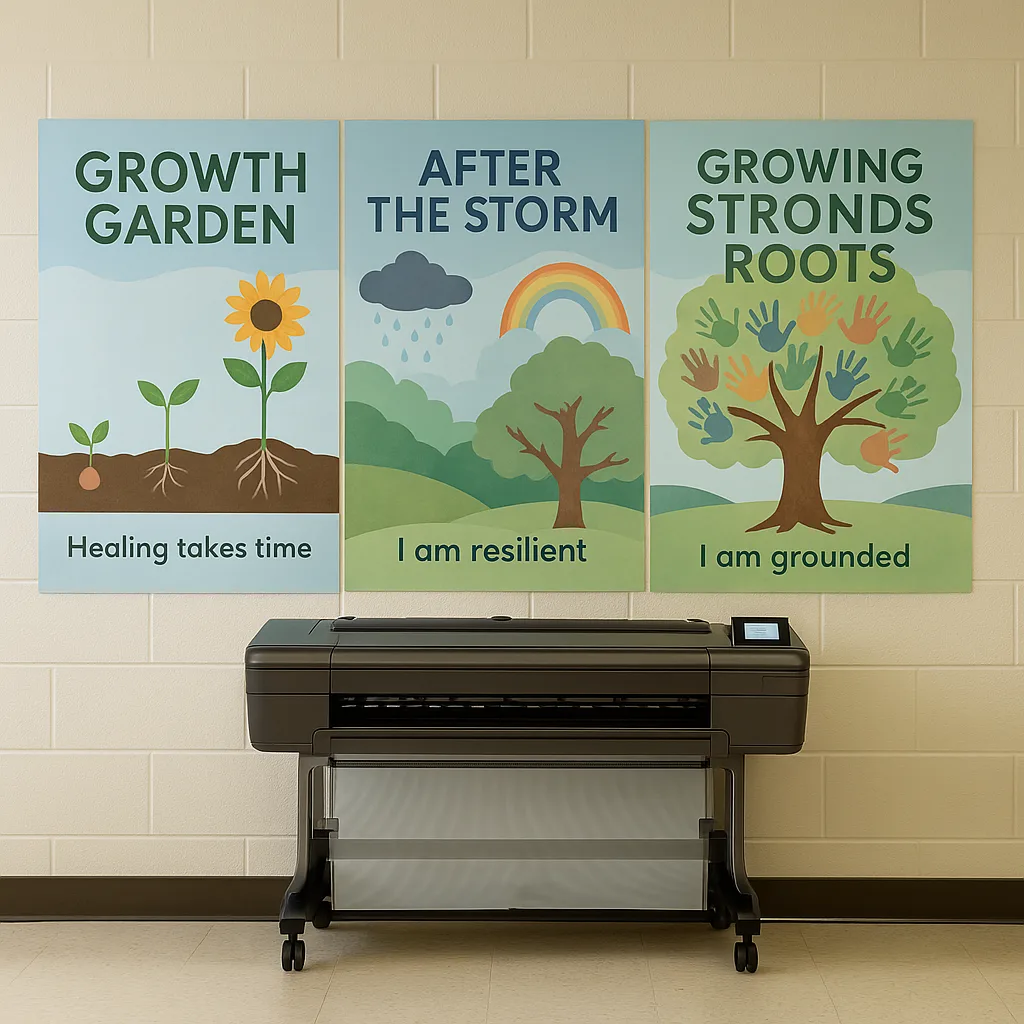
A healing-centered display created after community flooding, featuring growth metaphors and collective strength messages
Building Your Poster Printer for Schools Trauma Healing Toolkit
Students Report Feeling Safer
When classrooms include trauma-informed visuals
Increased Emotional Expression
Through visual storytelling activities
Teachers Feel More Equipped
To support students after crisis
Essential Components of Healing Visual Campaigns
Successful trauma-informed visual campaigns share common elements that promote healing while building community resilience. Here’s what I’ve seen work across diverse school settings:
1. Acknowledgment Without Overwhelm
Create posters that name the difficulty without dwelling on details. “Our community faced a storm, and we’re healing together” validates experiences without retraumatization.
2. Collective Identity Building
Use inclusive language and imagery that reinforces belonging. Posters featuring diverse students engaged in supportive activities remind everyone they’re part of something larger.
3. Action-Oriented Messages
Move beyond passive comfort to active coping. “Today I can: breathe deeply, ask for help, share my feelings” empowers students with concrete strategies.
4. Progress Documentation
Create visual timelines showing community recovery. This helps students see movement even when progress feels slow.
Real Stories: Schools Using Poster Printers for Healing
Hurricane Recovery in Coastal Elementary
After Hurricane Maria, a Puerto Rico elementary school used their poster printer for schools to create a “Strength Wall.” Students contributed drawings of what made them feel safe, which were compiled into large posters. The visual representation of collective resilience became a daily reminder of their community’s power.
Community Violence Response in Urban Middle School
Following a neighborhood shooting, Chicago middle schoolers created “Peace Path” posters lining their hallways. Each poster featured student-generated affirmations and coping strategies. The lifetime design service helped create templates that students could personalize while maintaining visual cohesion.
Wildfire Recovery in Rural District
A California district affected by wildfires developed “Phoenix Rising” campaigns. Students created before-and-after posters showing regrowth in nature alongside their own healing journeys. The visual metaphor helped process loss while emphasizing renewal.
Implementation Guide: Your First Healing Campaign
Week 1: Community Assessment
Survey students, families, and staff about visual preferences and triggers. What images bring comfort? Which colors feel safe? This collaborative approach ensures your campaign reflects community needs.
Week 2: Co-Creation Sessions
Host small group sessions where students contribute ideas. Provide templates but encourage personalization. The coated poster paper works beautifully for collaborative projects where multiple students add elements.
Week 3: Production and Placement
Print initial posters and strategically place them. Entry areas, counseling offices, and quiet corners benefit most from healing visuals. Monitor student responses and adjust placement as needed.
Week 4: Reflection and Iteration
Gather feedback through drawings, discussions, or written responses. What’s working? What needs adjustment? This ongoing dialogue keeps campaigns responsive to evolving needs.
Measuring Impact: Beyond Traditional Metrics
Traditional academic measures don’t capture healing progress. Instead, look for:
• Increased peer interactions near healing displays
• Student-initiated poster creation showing agency
• Decreased crisis responses in visual-rich environments
• Family engagement with take-home versions
• Teacher reports of improved classroom climate
Document these observations through photos, anecdotal records, and simple surveys. This data helps refine your approach and demonstrates impact to stakeholders who might question investing in visual healing resources.
Sustaining Healing Environments Long-Term
Regular Refresh Cycles
Keeping Content Current
Update healing posters seasonally to reflect ongoing growth. What supported students in crisis aftermath might need evolution as healing progresses. Plan quarterly reviews of visual content.Student Leadership
Peer Support Systems
Train older students as “Healing Artists” who help younger peers create visual stories. This peer support model builds leadership while distributing emotional labor across the community.Resources for Ongoing Support
Building healing-centered visual environments requires ongoing learning and support. Here are essential resources:
Professional Development
• Trauma-Informed Oregon offers free visual communication modules
• National Child Traumatic Stress Network provides age-specific guidance
• Local mental health agencies often provide consultation
Design Resources
The lifetime design service connects you with trauma-informed designers who understand educational contexts. They can help translate healing concepts into age-appropriate visuals.
Community Partnerships
• Local art therapists can guide visual healing strategies
• Cultural centers ensure inclusive representation
• Mental health professionals validate trauma-informed approaches
Material Considerations
Choose materials that support your healing goals. The satin photo paper reduces glare in spaces where students might feel overwhelmed by bright reflections.
Moving Forward: Your Healing Journey Begins
Every healing journey starts with a single step. Whether your community faces natural disasters, violence, or collective loss, visual storytelling offers a path forward. Your poster maker printer becomes more than equipment—it’s a tool for transformation.
Start small. Listen deeply. Create thoughtfully. Trust the process.
Your students’ resilience will guide the way, and their visual stories will light the path toward collective healing. Together, you’ll build not just beautiful classroom displays, but environments where trauma transforms into strength, isolation becomes connection, and crisis catalyzes community.

